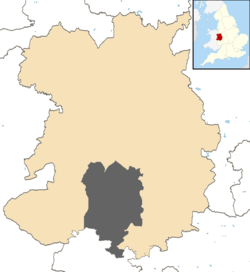| Munslow | |
|---|---|
| Hundred of Shropshire | |
 Munslow shown (in grey) within Shropshire | |
| Area | |
| • 1831 | 84,500 acres (34,200 ha) |
| • 1868 | 103,750 acres (41,990 ha) |
| Area transferred | |
| • c. 1200 | Places with Priory connection to Wenlock |
| • 1836 | Five from Wenlock's detached parts |
| - 1895 | Ludford (remainder) from Wolphy |
| History | |
| • Preceded by | Anglo-Saxon hundreds of Culvestan & Patton |
| • Origin | 12th century reforms of the county's hundreds |
| • Created | c. 1100-35 |
| • Succeeded by | elected parish & district councils (Local Government Act 1894) |
| Status | Hundred (obsolete since 1895) |
| Government | Hundred court |
| • HQ | (Aston) Munslow |
| Contained within | |
| • County | Shropshire |
| Subdivisions | |
| • Type | Divisions |
| • Units | Upper and Lower |
Munslow is a hundred of Shropshire, England. It was formed with the amalgamation of the Anglo-Saxon hundreds of Patton and Culvestan during the reign of Henry I (1100 to 1135). Hundreds in England had various judicial, fiscal and other local government functions, their importance gradually declining from the end of manorialism to the latter part of the 19th century.
The hundred is named after the village of Munslow, where the hundred's judicial and administrative functions were mostly carried out. The 'hundred house' for Munslow hundred was originally located in neighbouring Aston Munslow,[1] but from the Tudor period was located in Munslow itself.